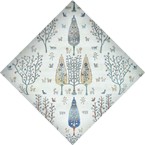Oushak rugs originated in the small town of Oushak in west central Anatolia, just south of Istanbul, Turkey. Unlike most Turkish rugs, Oushak rugs are most definitely Persian influenced.
Oushak has been a production center of Turkish rugs since the 15th century and today these beautiful area rugs are produced in Iran as well. Prior to this, Oushak rugs were woven by nomads for their necessities of life. After the design revolution took place in the late 15th century, area rugs began to be produced in Oushak for commercial purposes due to easy access to superb wool and natural dyes. Oushak rugs produced in Turkey and Iran remain in very high demand due in large part to their excellent quality. They tend to be more coarsely woven than other Persian rugs, and are always woven with the Ghiordes knot.
The designs on Oushak rugs are typically based on geometric motifs, frequently of a prayer niche design. This is due largely to the fact that since most Turks are Muslims, they observe the prohibition against the depiction of people and animals. Many feature intricate motifs of vines and leaves. Oushak rugs are distinctive in both pattern and color palette. Most have a dark ivory or golden background accented by red geometric or floral motifs. The use of ivory, gold, and red is particular to Oushak rugs. The sacred color, green, is used on prayer rugs. All of the rich colors are created with natural vegetable dyes.
The foundations of Oushak rugs are cotton, while the pile is wool. They normally range from small to mid-size because of the primitive looms that are used, although large rugs can be found. Oushak rugs are all double knotted for durability. These magnificent tribal designs can add a splash of color to any room in the house and are so versatile that they can be used as throws and mats in addition to floor coverings.























Be the first to know about new designs and
exclusive offers, and get up to
10% OFF
your first purchase

Rugman.com since 1998 | The first and oldest online rug store
You can unsubscribe with a single click. We value your privacy; click here for more info.

You have one more step to join
Rugman Insider Club.
A coupon code will be emailed to you.
Please check your email and just
click the green “Confirm Subscription” button.

